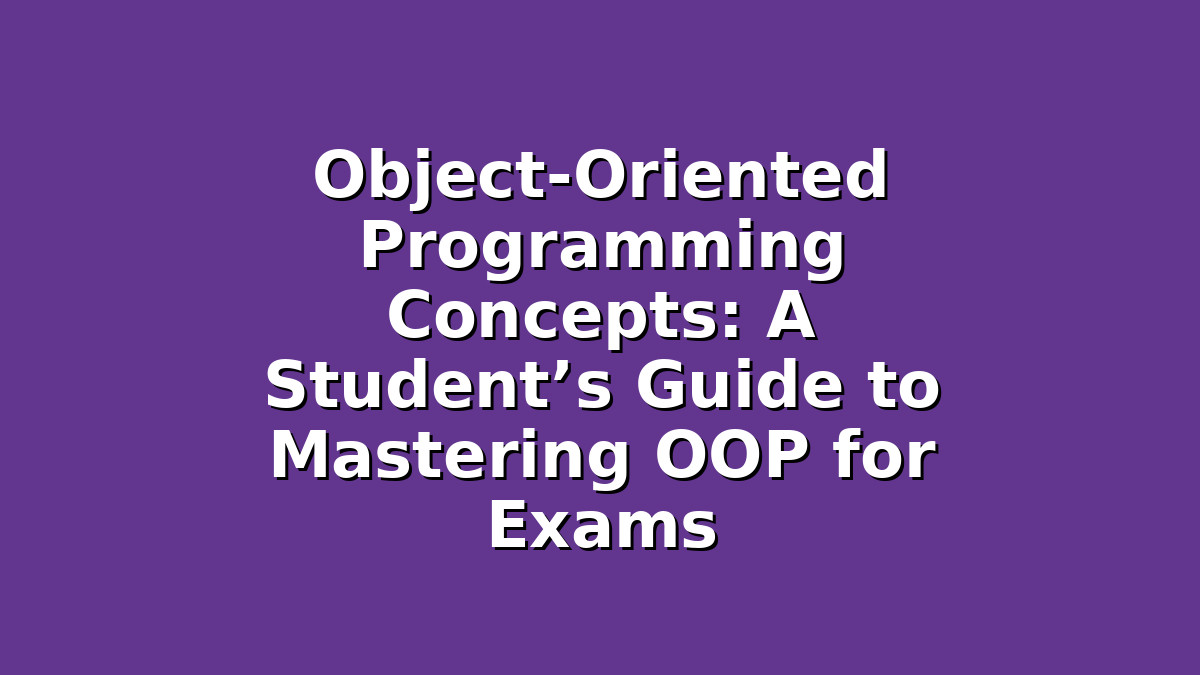If you’re a student preparing for programming exams or just diving into software development, understanding Object-Oriented Programming (OOP) is essential. OOP forms the backbone of many modern programming languages like Java, C++, Python, and C#. Grasping its fundamental concepts will not only help you ace your exams but also build a strong foundation for your career as a programmer.
In this article, we’ll break down the core OOP concepts and provide practical tips to help you study effectively. Whether you’re revisiting these topics or encountering them for the first time, this guide is designed to encourage and support your learning journey.
—
Introduction to Object-Oriented Programming
Object-Oriented Programming is a programming paradigm centered on the concept of “objects.” These objects can be thought of as real-world entities that have attributes (properties) and behaviors (methods). Unlike procedural programming, which relies on functions and routines, OOP organizes code around objects, making programs easier to manage, reuse, and extend.
Four fundamental principles define OOP:
– Encapsulation
– Inheritance
– Polymorphism
– Abstraction
Understanding these concepts deeply is crucial for exam success and practical application. Below, we’ll explore each concept and share study strategies that can help you internalize and recall them effectively.
—
1. Encapsulation: Understanding Data Protection and Organization
What is Encapsulation?
Encapsulation is the practice of bundling data (attributes) and methods (functions) that operate on that data into a single unit, called a class. It also involves restricting direct access to some components of that object to prevent unintended interference and misuse. This is typically achieved through access modifiers like `private`, `protected`, and `public`.
For example, think of a class `Student` with attributes like `name` and `grade`. By encapsulating these attributes, you can control how other parts of the program access or modify them, ensuring data integrity.
Study Tips for Encapsulation
– Create Practical Examples: Write simple classes such as `BankAccount` or `Car` and practice using access modifiers to protect the data. Experiment with getters and setters to control access.
– Use Flashcards: Make flashcards with terms like “encapsulation,” “access modifiers,” and their definitions or use cases. This is excellent for quick reviews.
– Relate to Real Life: Imagine everyday objects with hidden properties. For example, a TV remote controls the TV but you don’t see its internal wiring. This analogy helps solidify the concept of hiding data inside classes.
– Practice Coding Questions: Many exam questions ask you to identify or implement encapsulation. Practice writing classes where you hide data and provide controlled access.
—
2. Inheritance: Building Relationships Between Classes
What is Inheritance?
Inheritance allows a new class (child or subclass) to inherit the properties and methods of an existing class (parent or superclass). This promotes code reuse and establishes a natural hierarchy. For example, if you have a class `Animal` with methods like `eat()` and `sleep()`, you can create subclasses like `Dog` and `Cat` that inherit these methods but also add their own.
Study Tips for Inheritance
– Draw Class Hierarchies: Visual diagrams help in understanding inheritance trees and relationships between classes. Use tools like pen and paper or digital diagram software.
– Compare and Contrast: List differences between parent and child classes. Note what is inherited, overridden, or newly added.
– Code Inheritance Examples: Write code snippets where subclasses override or extend parent class methods. This helps you understand polymorphism too.
– Explain to a Peer: Teaching the concept to someone else forces you to clarify your understanding. You can even create mini-presentations or study group discussions focused on inheritance.
—
3. Polymorphism and Abstraction: Mastering Flexibility and Simplification
Polymorphism
Polymorphism means “many forms” and allows methods to do different things based on the object that is invoking them. It mainly appears as method overloading (same method name, different parameters) and method overriding (subclass provides a specific implementation of a method defined in the parent class).
For example, a method `draw()` might behave differently for classes `Circle`, `Square`, or `Triangle` — each drawing its respective shape.
Abstraction
Abstraction involves hiding complex implementation details and showing only the essential features of an object. It helps reduce complexity by focusing on what an object does rather than how it does it. Abstract classes and interfaces are common ways to achieve abstraction.
Study Tips for Polymorphism and Abstraction
– Use Analogies: Think of polymorphism like a universal remote that can control various devices, each responding differently to the same button press.
– Practice Method Overloading and Overriding: Write multiple versions of the same method and experiment with parameters and overrides.
– Work Through Abstract Classes: Create abstract classes and interfaces in your preferred language and implement them in subclasses.
– Summarize with Examples: Write short notes that pair definitions with simple code snippets or diagrams. This will help reinforce the concepts during revision.
– Solve Past Papers: Look for exam questions that require you to identify or implement polymorphism and abstraction. Practice explaining your answers clearly.
—
Conclusion: Your Path to OOP Mastery
Mastering Object-Oriented Programming concepts can seem overwhelming at first, but with consistent practice and the right strategies, you can build a solid understanding that will serve you well in exams and practical programming.
Remember to break down each concept into manageable parts, relate them to real-world examples, and practice coding regularly. Use visual aids like diagrams and flashcards, and don’t hesitate to teach what you’ve learned to classmates or friends. Teaching is a powerful tool for retention.
Lastly, stay positive and patient. Programming is a skill that improves with time and effort. Keep practicing, and soon OOP will feel like second nature.
Good luck with your studies—you’ve got this!
—

Responses